12 Best Compensation Management Software Tools for 2025
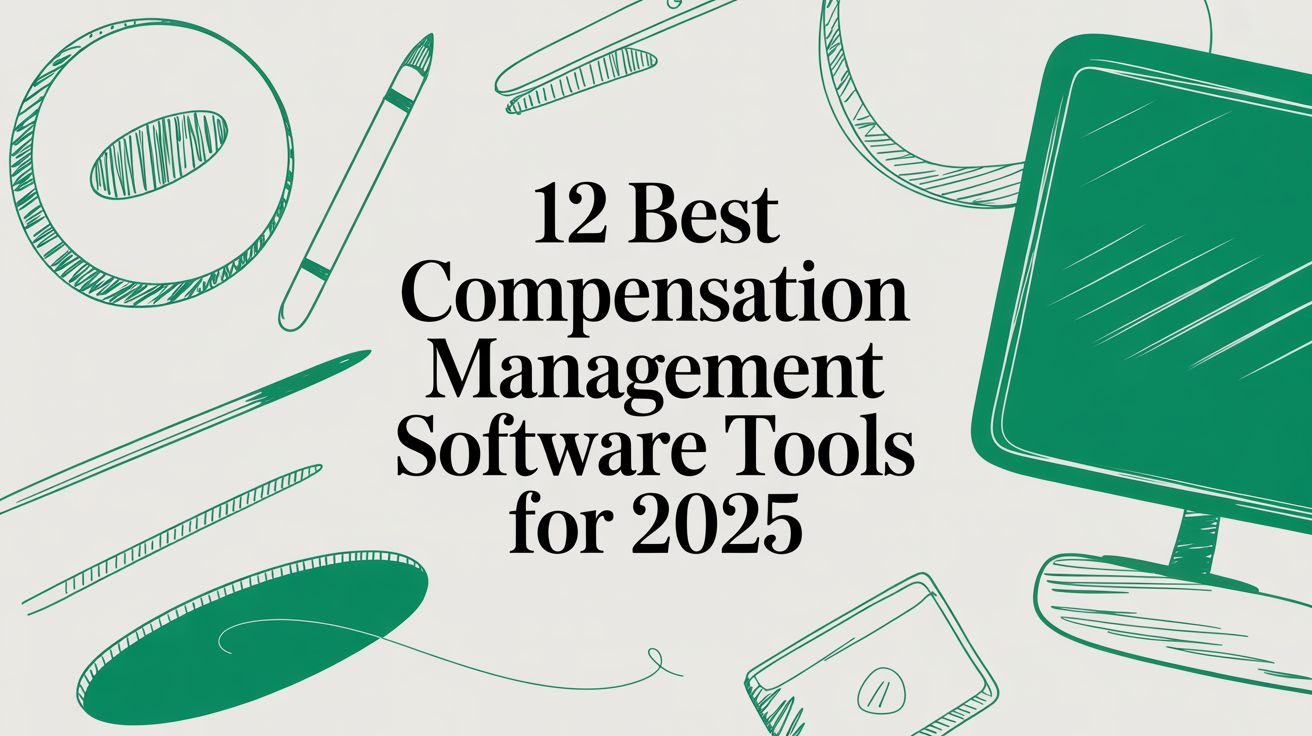
In today's competitive talent market, especially within fast-moving fields like marketing, managing compensation with spreadsheets is no longer a viable strategy. Getting pay right is critical for attracting, motivating, and retaining top performers. Modern best compensation management software automates complex workflows, provides real-time market data, helps ensure pay equity, and communicates total rewards effectively. This transition is not just about efficiency; it's about making strategic, data-driven decisions that align with business goals.
However, navigating the crowded marketplace of solutions can be overwhelming. With a wide array of options, from comprehensive enterprise HCM suites like Workday and SAP SuccessFactors to specialized platforms like Pave and SalaryGuide, choosing the right tool is a significant challenge. How do you determine which system best fits your specific needs, whether you're a senior marketing executive evaluating equity plans, an agency owner setting competitive pay scales, or an HR team focused on market intelligence?
This guide is designed to cut through the noise and provide clear, actionable insights. We will deliver an in-depth analysis of the top 12 compensation management software platforms available today. For each option, you'll find a detailed breakdown of its key features, ideal use cases, and practical limitations. We include screenshots and direct links to help you find the perfect fit for your organization's unique compensation management requirements and accelerate your decision-making process.
1. SalaryGuide
SalaryGuide carves out a unique and powerful niche in the landscape of compensation management software by focusing exclusively on the marketing industry.## 1. SalaryGuide
SalaryGuide carves out a unique and powerful niche in the landscape of compensation management software by focusing exclusively on the marketing industry. This hyper-specific approach allows it to deliver exceptionally relevant and real-time salary intelligence that generalist platforms often lack. It combines a user-driven database of over 4,000 verified, recent salary submissions with a suite of AI-powered career tools, making it an indispensable resource for marketing professionals and the HR teams that support them.
The platform's strength lies in its data integrity. SalaryGuide only aggregates submissions from the last 12 months and employs a multi-step verification process to ensure accuracy and remove outliers. This commitment to fresh, vetted data allows users to see precise median salaries for specific roles, companies, and locations, providing a clear picture of their market value.
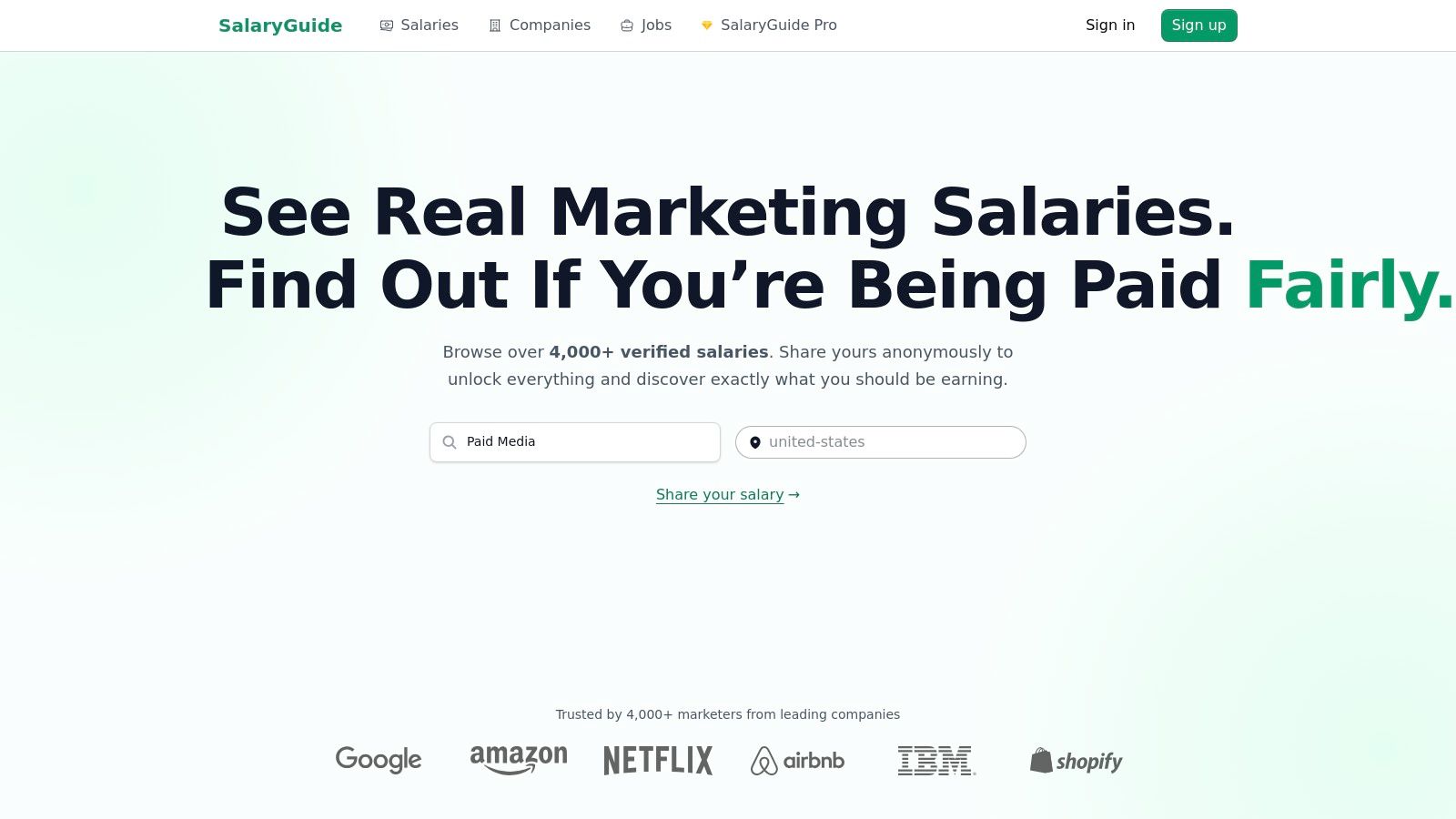
Key Features and Use Cases
SalaryGuide distinguishes itself by packaging its data within a comprehensive toolkit designed for both individual career growth and organizational planning.
- For Individual Marketers: Professionals in SEO, paid media, and content can anonymously submit their salary to unlock the full database. This provides instant access to personalized market position analysis, helping them benchmark their pay and confidently enter negotiations. The platform also offers negotiation playbooks and curated job listings.
- For Employers and HR Teams: The platform provides employer-grade analytics through interactive dashboards and APIs. This allows marketing agencies, HR leaders, and hiring managers to conduct robust talent benchmarking, inform compensation planning, and ensure their pay scales are competitive enough to attract and retain top marketing talent.
Why It Stands Out
What makes SalaryGuide a top choice is its singular focus on the marketing ecosystem. While broad compensation tools provide a general market overview, SalaryGuide offers the granular, role-specific data that is critical for a rapidly evolving field like marketing. A digital marketing manager's compensation structure is vastly different from a software engineer's, and this platform understands that nuance.
Practical Tip: To maximize value, contribute your own anonymized salary data. This not only strengthens the community dataset but also unlocks a more detailed, personalized report of how your compensation compares to peers in similar roles, locations, and company types.
Pros:
- Marketing-Specific Data: Highly relevant, verified salary information for roles like SEO, paid media, content, and communications.
- Data Freshness and Integrity: Focuses on recent (last 12 months) submissions with a multi-step verification process.
- All-in-One Toolkit: Combines salary data with AI career tools, job listings, and negotiation guidance.
- Employer-Grade Analytics: Offers powerful dashboards and APIs for comprehensive compensation planning.
Cons:
- Opaque Pricing: Costs for premium reports and the "Pro" tier are not listed publicly on the site.
- Niche Data Gaps: Very specific job titles or smaller geographic locations may have limited data points.
Website: https://salaryguide.com
2. Workday – Compensation Management
Workday offers an enterprise-grade compensation management solution seamlessly integrated within its broader Human Capital Management (HCM) suite. It excels at consolidating complex pay structures, including salary, bonus, and stock planning, into a single system of record. This integration is its key differentiator, making it an ideal choice for large organizations already invested in the Workday ecosystem for HR, payroll, and talent management.

The platform empowers HR leaders and managers to execute compensation reviews, model budget scenarios, and analyze pay equity across global teams with configurable rules and currency support. Employees also benefit from self-service access to clear, comprehensive total rewards statements, enhancing transparency.
Core Features & Analysis
- Unified Planning: Workday centralizes merit, bonus, and stock planning, preventing data silos and ensuring consistency. This is crucial for large marketing departments with diverse roles and pay scales.
- Pay Equity Dashboards: Provides powerful analytics to identify and address pay disparities, a critical function for maintaining fairness and compliance.
- Global Configuration: Supports multiple currencies and configurable eligibility rules, essential for international marketing agencies and enterprise teams.
- Total Rewards Statements: Generates on-demand statements that articulate the full value of an employee's compensation package beyond just salary.
Pricing and Implementation
Workday’s pricing is quote-based and reflects its premium, enterprise-level positioning. The total cost of ownership is generally higher than standalone tools. Implementation can be complex and often requires certified consultants, so factor this into your timeline and budget.
Our Take: For mid-to-large US organizations deeply embedded in the Workday ecosystem, its compensation module is one of the best compensation management software choices for its unparalleled integration and robust, scalable architecture. However, smaller businesses or those not using Workday HCM may find it too complex and costly for their needs.
3. SAP SuccessFactors – Compensation
SAP SuccessFactors provides a mature, cloud-based compensation solution integrated within its comprehensive Human Experience Management (HXM) Suite. It is engineered for large, global enterprises that require robust tools for managing complex compensation cycles, variable pay, and rewards. Its primary strength lies in its deep integration with the wider SAP ecosystem, making it a natural fit for organizations already utilizing SuccessFactors for core HR, payroll, and talent management.
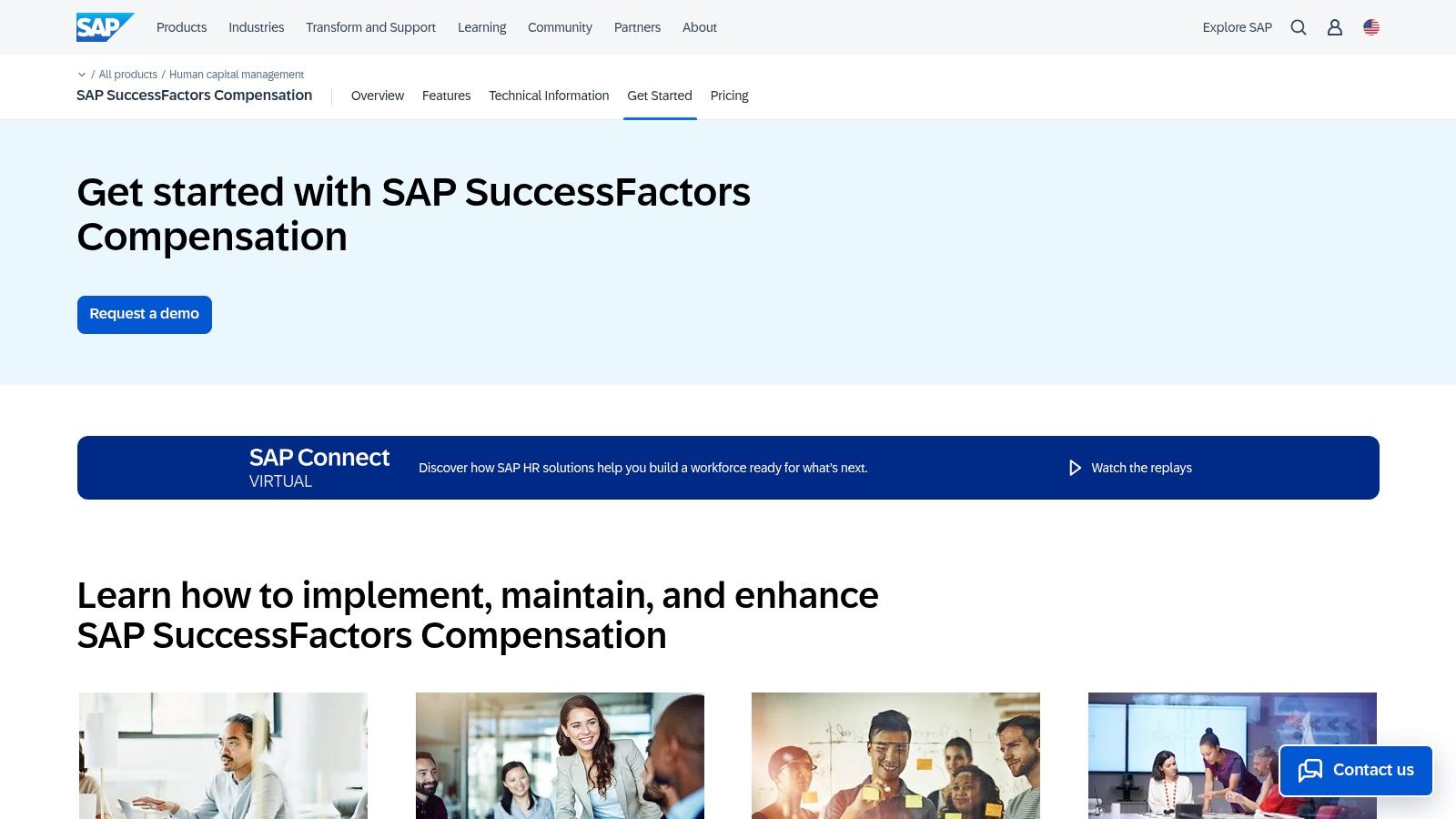
The platform enables HR leaders to manage budgets, apply guidelines, and facilitate approval workflows across different business units and countries. It places a strong emphasis on compliance and pay equity, providing analytics to help leaders make fair and data-driven compensation decisions. For marketing departments in multinational corporations, this ensures pay strategies are both competitive and equitable on a global scale.
Core Features & Analysis
- Guided Planning Cycles: Provides structured workflows with defined budgets and approval processes, simplifying complex annual review cycles for large teams.
- Variable Pay & Rewards: Offers robust functionality for managing bonuses, commissions, and other non-salary rewards, crucial for performance-driven marketing roles.
- Pay Equity & Transparency Tools: Delivers analytics to identify and address pay gaps, supporting fair pay initiatives and compliance with transparency regulations.
- Global Capabilities: Natively supports multiple currencies, languages, and country-specific regulations, making it ideal for international marketing organizations.
Pricing and Implementation
Similar to other enterprise systems, SAP SuccessFactors operates on a quote-based pricing model. The overall cost and implementation complexity are significant, often requiring specialized consultants and considerable planning. The best experience and value are realized when it's part of a broader SuccessFactors implementation.
Our Take: For global enterprises already committed to the SAP ecosystem, SuccessFactors is one of the best compensation management software options due to its powerful integrations and comprehensive, compliant feature set. Its enterprise-grade complexity and cost, however, make it unsuitable for small to mid-sized businesses or companies not already using SAP.
Website: https://www.sap.com/products/hcm/compensation-management/get-started.html
4. Oracle Cloud HCM – Compensation
Oracle Cloud HCM delivers a robust compensation management module designed for large, global enterprises. Similar to Workday, its primary strength lies in its deep integration within the broader Oracle ecosystem, connecting compensation planning directly with Core HR, talent management, and ERP systems. This makes it a powerful choice for organizations already leveraging Oracle's suite for their core business and HR functions.
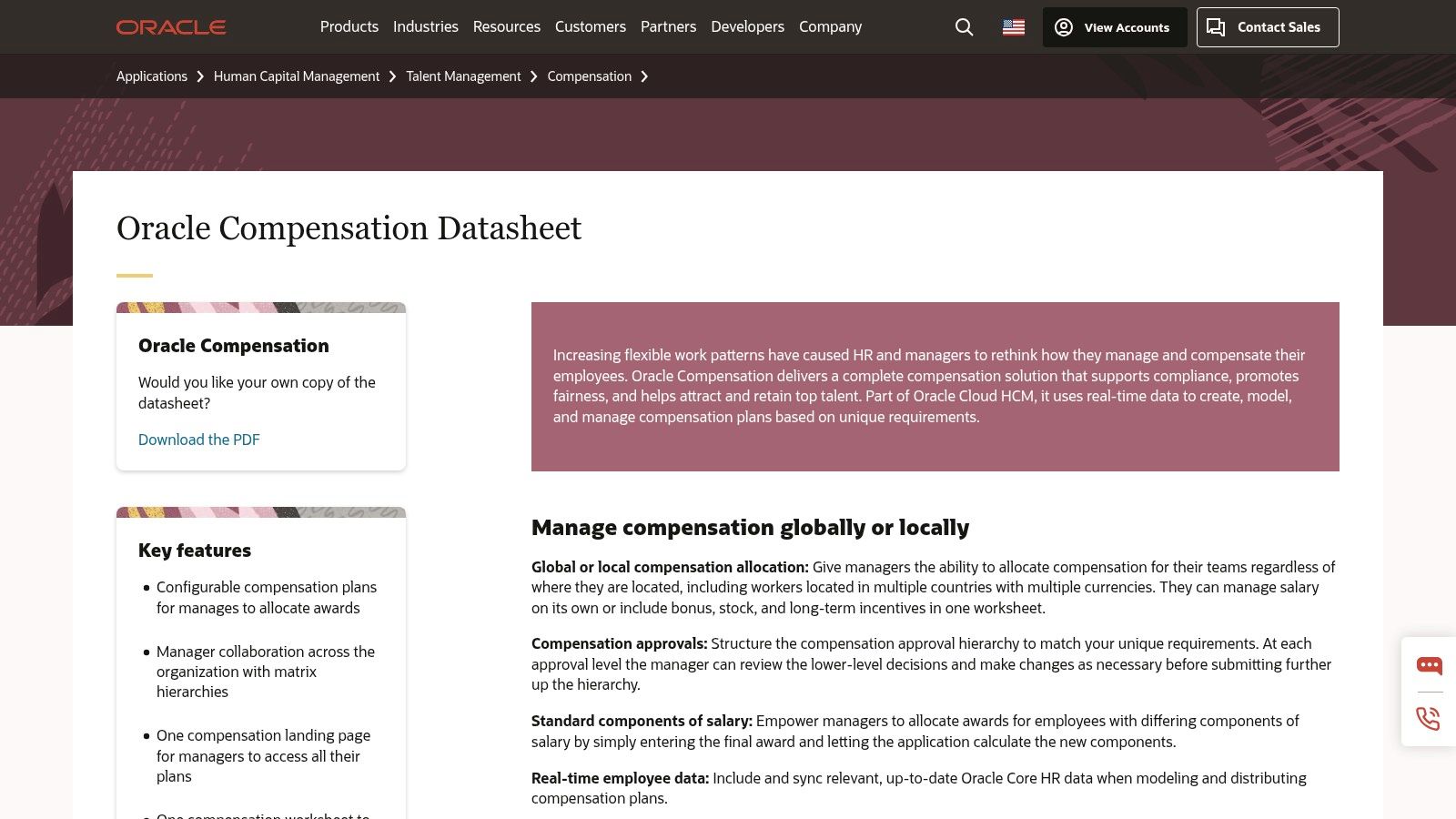
The platform equips managers with unified worksheets and landing pages, pulling real-time employee data to inform decisions on salary, bonus, and long-term incentives. Its ability to handle complex global allocations, with multiple currencies and configurable approval hierarchies, is a key feature for multinational companies standardizing their compensation review cycles.
Core Features & Analysis
- Unified Manager Worksheets: Consolidates all compensation tasks, from merit increases to stock awards, into a single interface for managers, streamlining the review process.
- Real-Time HR Data: Leverages live data from Oracle's Core HR module, ensuring compensation decisions are based on the most current employee performance and profile information.
- Global Capabilities: Natively supports multi-currency allocations and country-specific compensation rules, which is essential for large marketing organizations with a global footprint.
- Configurable Rules & Hierarchies: Allows for highly customized plan rules and approval workflows to match complex organizational structures and governance policies.
Pricing and Implementation
Oracle's pricing is quote-based and tailored for the enterprise market. The overall investment is significant and provides the most value when the organization is already committed to the Oracle Cloud HCM platform. Implementation is a considerable project that requires specialized expertise and careful planning.
Our Take: For large, multinational corporations already running on Oracle's HCM or ERP systems, this is one of the best compensation management software options available due to its seamless integration and powerful global capabilities. Organizations not invested in the Oracle ecosystem will likely find the platform too complex and costly for their compensation needs alone.
Website: https://www.oracle.com/human-capital-management/talent-management/compensation-datasheet/
5. ADP Workforce Now – Compensation Management (ADP Marketplace)
For the millions of businesses already using ADP for payroll, ADP Workforce Now offers a native compensation management module and access to a broad ecosystem of third-party apps via the ADP Marketplace. Its primary strength lies in its direct integration with ADP's payroll and HR systems, ensuring that compensation decisions made during review cycles are automatically reflected in employee records and paychecks without manual data entry. This streamlines the entire process from planning to execution.
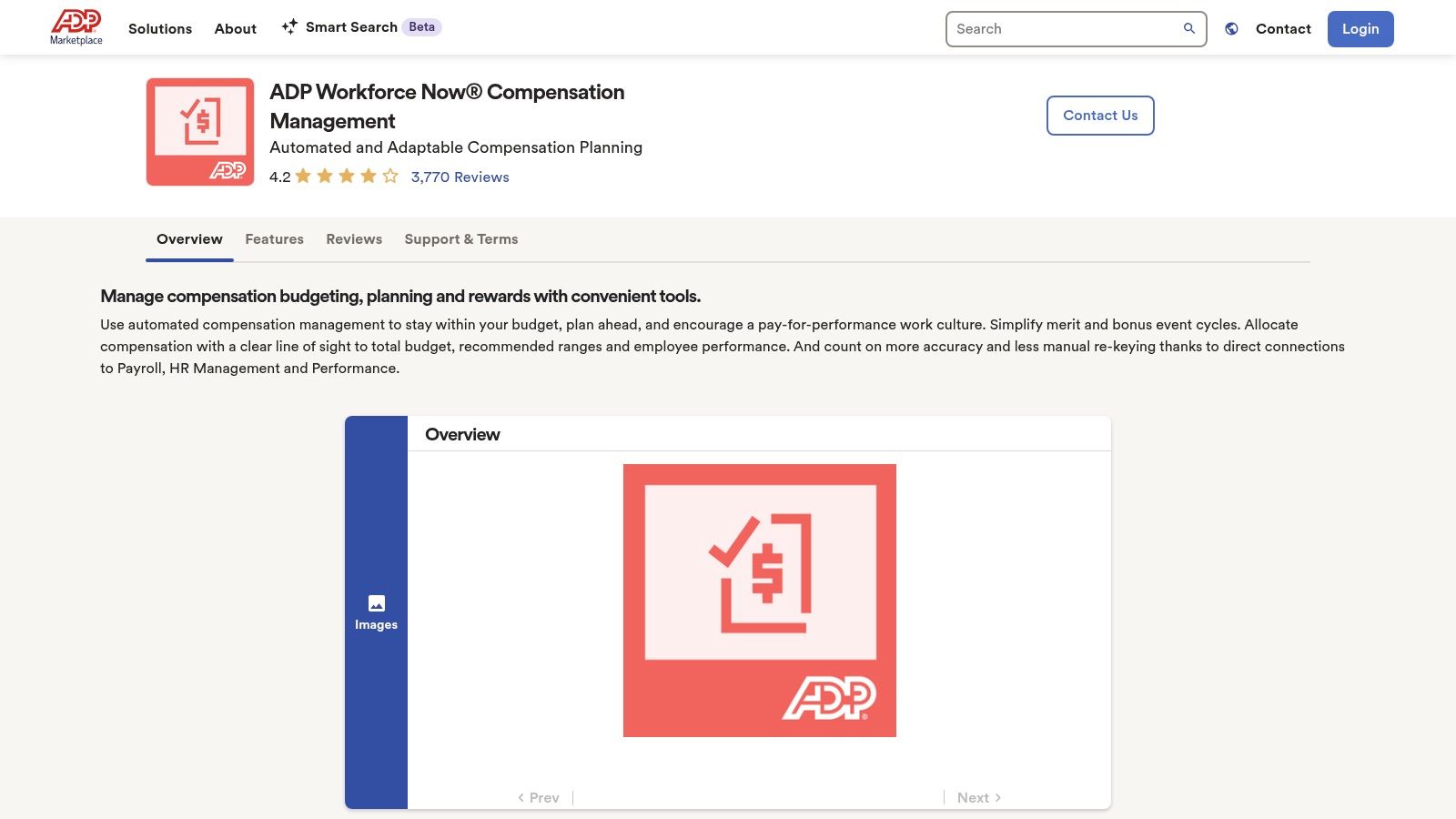
The platform provides managers with interactive worksheets and dashboards to model salary increases, allocate bonuses, and track budget adherence in real-time. The unique value proposition is the flexibility to either use ADP's built-in tools for core needs or connect specialized third-party compensation applications for more advanced requirements like pay equity analysis or market pricing, all while maintaining ADP as the central HR data hub.
Core Features & Analysis
- Interactive Planning Worksheets: Managers get access to decision-support tools and worksheets that pull real-time employee data, simplifying merit and bonus allocation.
- Real-Time Progress Dashboards: Provides HR and leadership with an at-a-glance view of budget consumption and review cycle progress across the organization.
- Direct HR & Payroll Updates: Approved compensation changes flow directly into ADP HR and payroll systems, eliminating errors and administrative overhead.
- ADP Marketplace Integration: Offers the flexibility to augment native capabilities by connecting with specialized partner applications for compensation, enhancing functionality as needed.
Pricing and Implementation
Pricing for ADP's native compensation module and its marketplace apps varies significantly. The ADP module is typically an add-on to a Workforce Now subscription, while marketplace app pricing is set by the third-party vendor. This often requires contacting vendors for quotes. Implementation is generally streamlined for existing ADP customers due to the native data connection.
Our Take: For US-based companies already reliant on ADP for payroll, its compensation module is a logical and efficient choice, making it one of the best compensation management software options for seamless integration. The ability to expand functionality via the marketplace is a major plus. However, businesses not using ADP may find standalone solutions more suitable, as the core benefit is tied to its ecosystem.
6. Salary.com – CompAnalyst
Salary.com's CompAnalyst platform is a data-driven solution that combines robust market pricing with comprehensive compensation planning tools. It stands out for its extensive library of HR-reported survey data, making it a go-to resource for organizations prioritizing accurate, US-centric benchmarking. The platform is designed specifically for compensation professionals, providing the analytics needed to build and manage salary structures effectively.
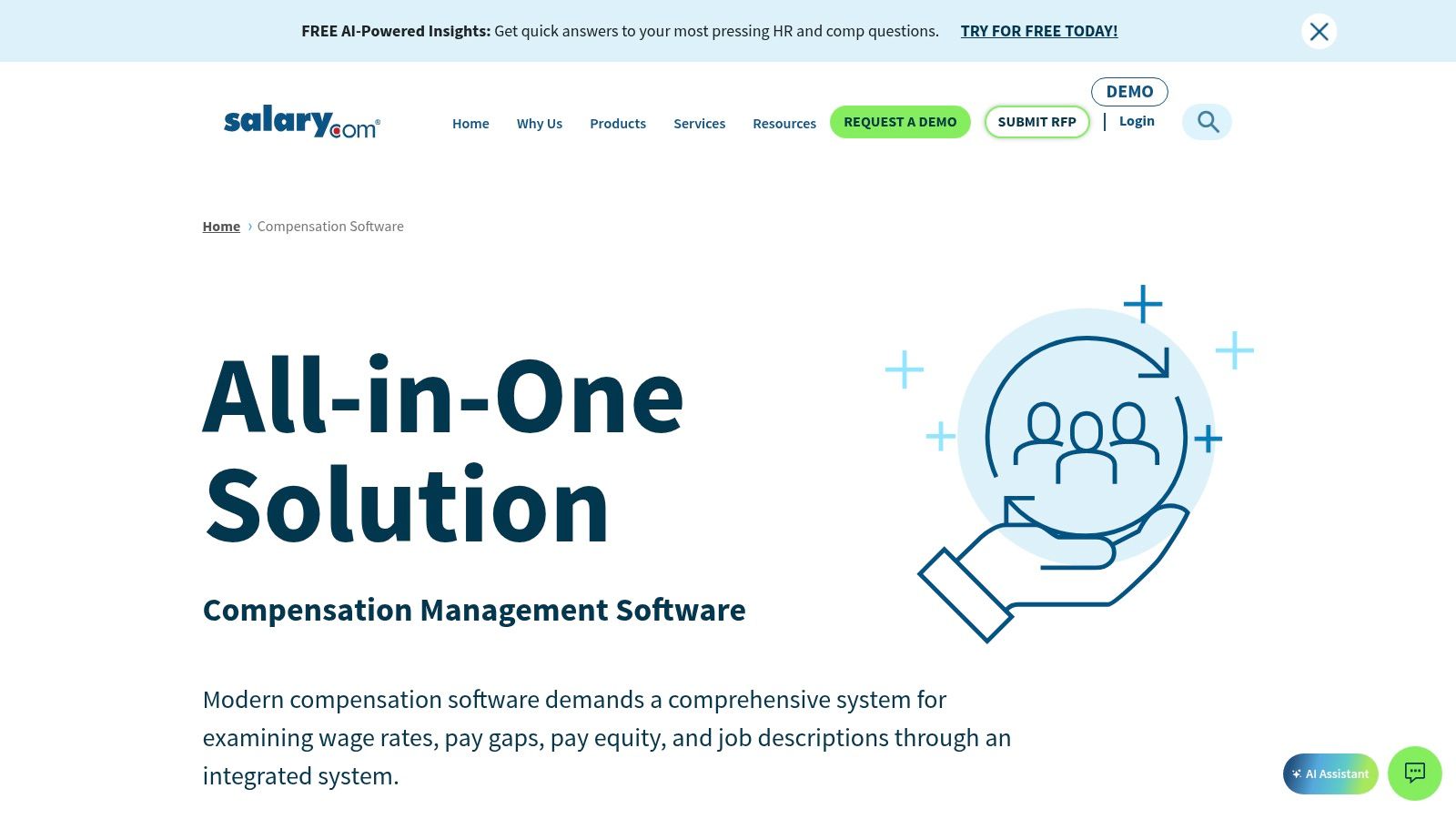
CompAnalyst excels at the foundational elements of compensation management, from job description management and market pricing to pay equity analysis and merit increase modeling. This focus makes it a powerful tool for marketing leaders and HR teams who need to ensure their pay scales are competitive and equitable, especially in fast-moving US markets.
Core Features & Analysis
- Market Pricing: Leverages an extensive database of HR-reported surveys to provide highly reliable salary benchmarks for a wide range of roles.
- Pay Equity Toolkit: Offers specialized analytics and reporting tools to identify and address pay gaps, helping ensure fairness and compliance.
- Salary Structure Development: Provides purpose-built workflows for creating, modeling, and managing salary ranges and pay grades.
- Job Description Management: Includes tools to build and maintain a library of consistent and market-relevant job descriptions.
Pricing and Implementation
Pricing for CompAnalyst is quote-based, and the total cost can vary significantly depending on the modules and data sets you select. The platform is designed to be modular, so organizations can start with core features and add functionality like pay equity or merit planning as needed. Implementation is generally more straightforward than large HCM suites.
Our Take: For US-based marketing teams and HR departments that need best-in-class benchmark data and dedicated compensation workflows, CompAnalyst is one of the best compensation management software options available. Its strength lies in its data accuracy and specialized tools, though it's most cost-effective for companies leveraging multiple modules.
Website: https://www.salary.com/business/compensation-software/
7. Payscale (Payfactors / MarketPay / Paycycle)
Payscale offers a suite of modern compensation software that connects real-time market data with robust planning and communication tools. Its key advantage lies in its tiered product structure, which caters to a wide range of organizations from small businesses to large enterprises. This flexibility allows companies to start with foundational market data and scale into more complex planning modules as their needs evolve.
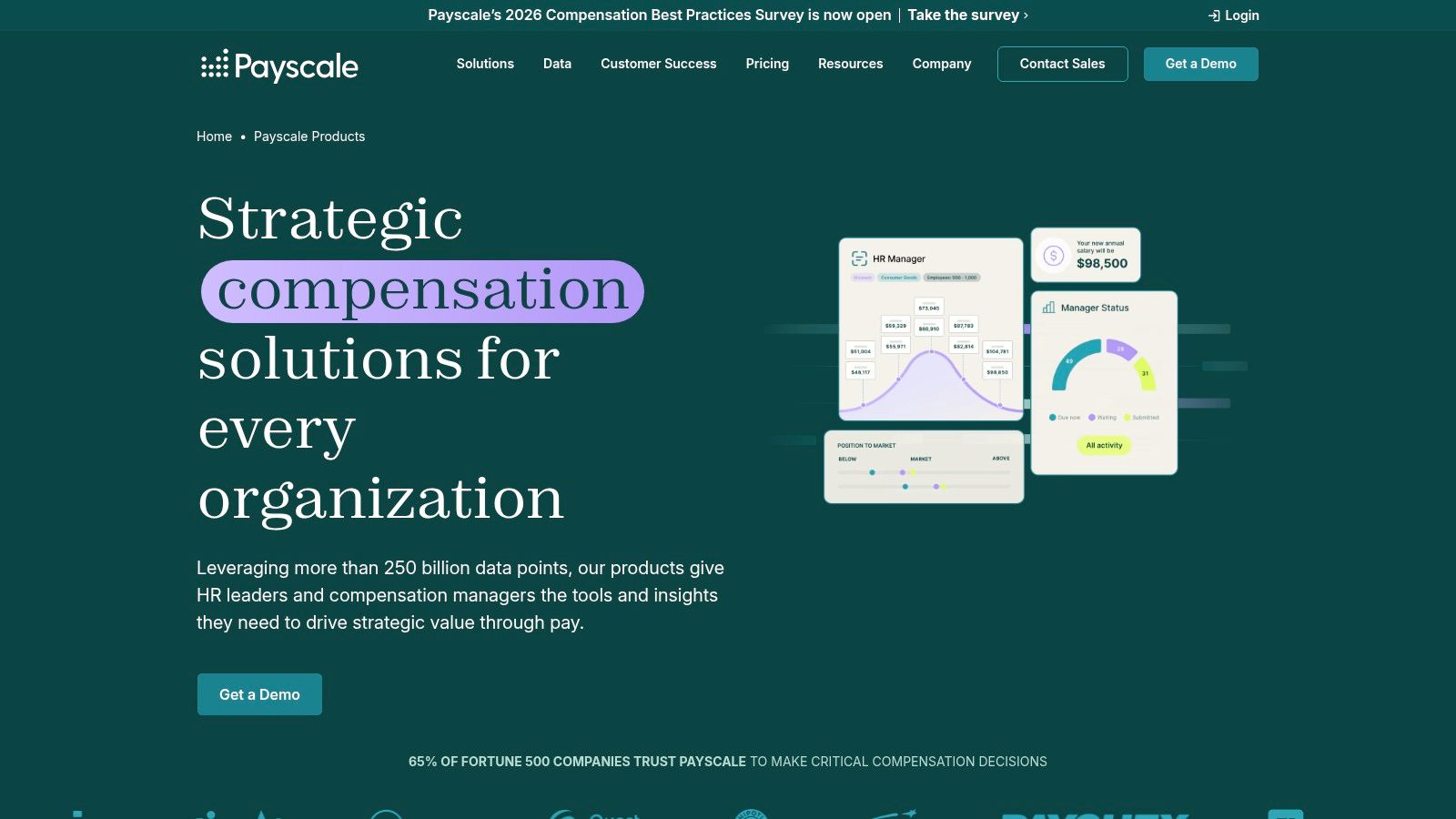
The platform is designed to empower HR and marketing leaders with the data-driven insights needed to build competitive pay strategies. By combining crowd-sourced and company-sourced data, Payscale provides a comprehensive view of the market, helping businesses attract and retain top talent in fast-moving industries like marketing.
Core Features & Analysis
- AI-Assisted Market Pricing: Leverages AI to provide real-time market insights and job pricing, helping teams quickly and accurately benchmark roles.
- Consolidated Market Data: Manages and consolidates data from multiple survey sources into a single, reliable point of reference, simplifying analysis.
- Flexible Compensation Planning: Includes tools for managing budgets, creating pay guidelines, and modeling different compensation scenarios for merit, bonus, and equity cycles.
- Total Rewards Communication: Provides features to create and share personalized total rewards statements, improving employee understanding and appreciation of their full compensation package.
Pricing and Implementation
Payscale offers multiple product tiers, including a free Market Data option that operates on a "give-to-get" model, requiring data contribution. Paid modules for more advanced features like compensation planning and survey management are quote-based. The tiered approach makes it more accessible than many enterprise-only systems, but be aware that access to the best data often requires sharing your own HRIS data.
Our Take: For SMBs and mid-market companies needing a data-centric solution that can scale with them, Payscale is one of the best compensation management software options available. The free data tier is an excellent entry point, though the user experience can vary across its different product modules.
Website: https://www.payscale.com/products
8. Pave – Compensation Intelligence Platform
Pave modernizes compensation management with a focus on real-time benchmarking and data-driven insights, making it a favorite among fast-growing tech companies and startups. The platform connects directly to your HRIS, payroll, and equity systems to pull live, anonymized data, which powers its machine-learning models for highly accurate market pricing. Its key differentiator is a powerful free tier that provides access to this benchmark data, lowering the barrier to entry for smaller firms.
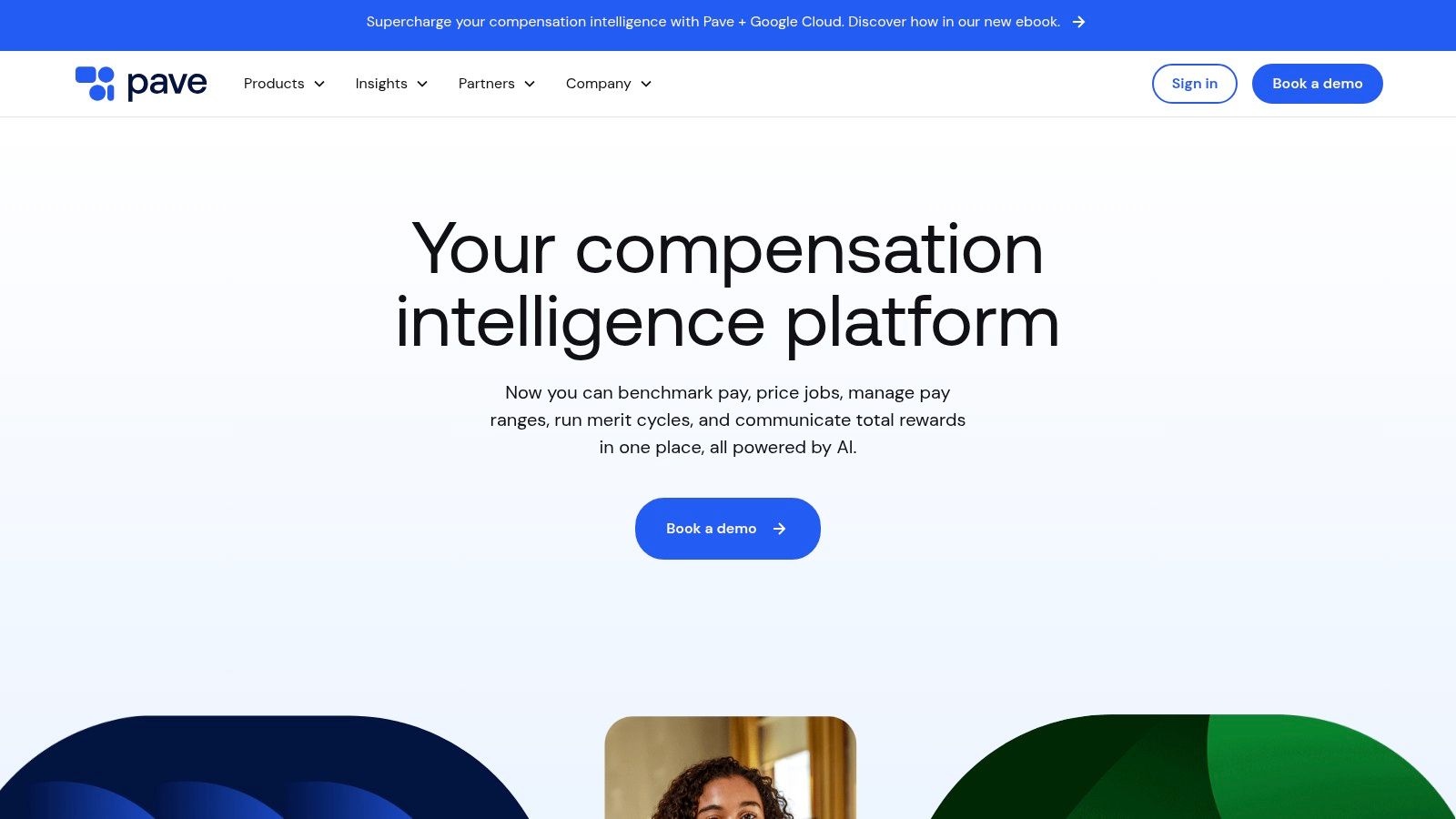
The platform is designed for agility, offering integrated workflows for merit cycle planning and visual total rewards statements that help companies communicate value effectively. These tools are crucial for marketing teams in competitive markets where attracting and retaining top talent requires a clear and compelling compensation story. By democratizing access to data, Pave helps leaders make confident pay decisions.
Core Features & Analysis
- Live Compensation Benchmarks: Utilizes real-time, aggregated data from participating companies for more accurate and current salary, bonus, and equity benchmarks than traditional surveys.
- Visual Offer Letters & Total Rewards: Creates dynamic, interactive portals that showcase the full value of a compensation package, including equity and benefits.
- Merit Cycle Planning: Provides streamlined workflows for managers to conduct compensation reviews with budget controls, analytics, and HRIS integration.
- API & Integrations: Connects seamlessly with major HRIS and ATS platforms to ensure data is always up-to-date, reducing manual data entry and errors.
Pricing and Implementation
Pave offers a "Give-to-Get" model where organizations can access benchmark data for free by connecting their HR systems. Paid plans like Market Data Pro and a full Compensation Cycle Management suite are available via custom quotes for advanced features, analytics, and workflows. Implementation is notably fast due to its integration-first approach.
Our Take: Pave is among the best compensation management software options for startups and scale-ups, especially in the tech sector. Its modern UI, real-time data model, and focus on total rewards communication align perfectly with the needs of agile marketing organizations. It promotes a culture of fairness and helps companies remain competitive in a landscape increasingly focused on pay transparency.
Website: https://www.pave.com/
9. beqom – Total Compensation & Pay Equity
beqom delivers a specialized, enterprise-grade compensation platform designed for large, global organizations with complex pay structures. It excels at managing the entire rewards process, from salary and bonus to long-term incentives (LTI) and sales compensation, all within a single, highly configurable system. Its core strength lies in its ability to handle scale and intricate compliance requirements, making it a top choice for multinational corporations.
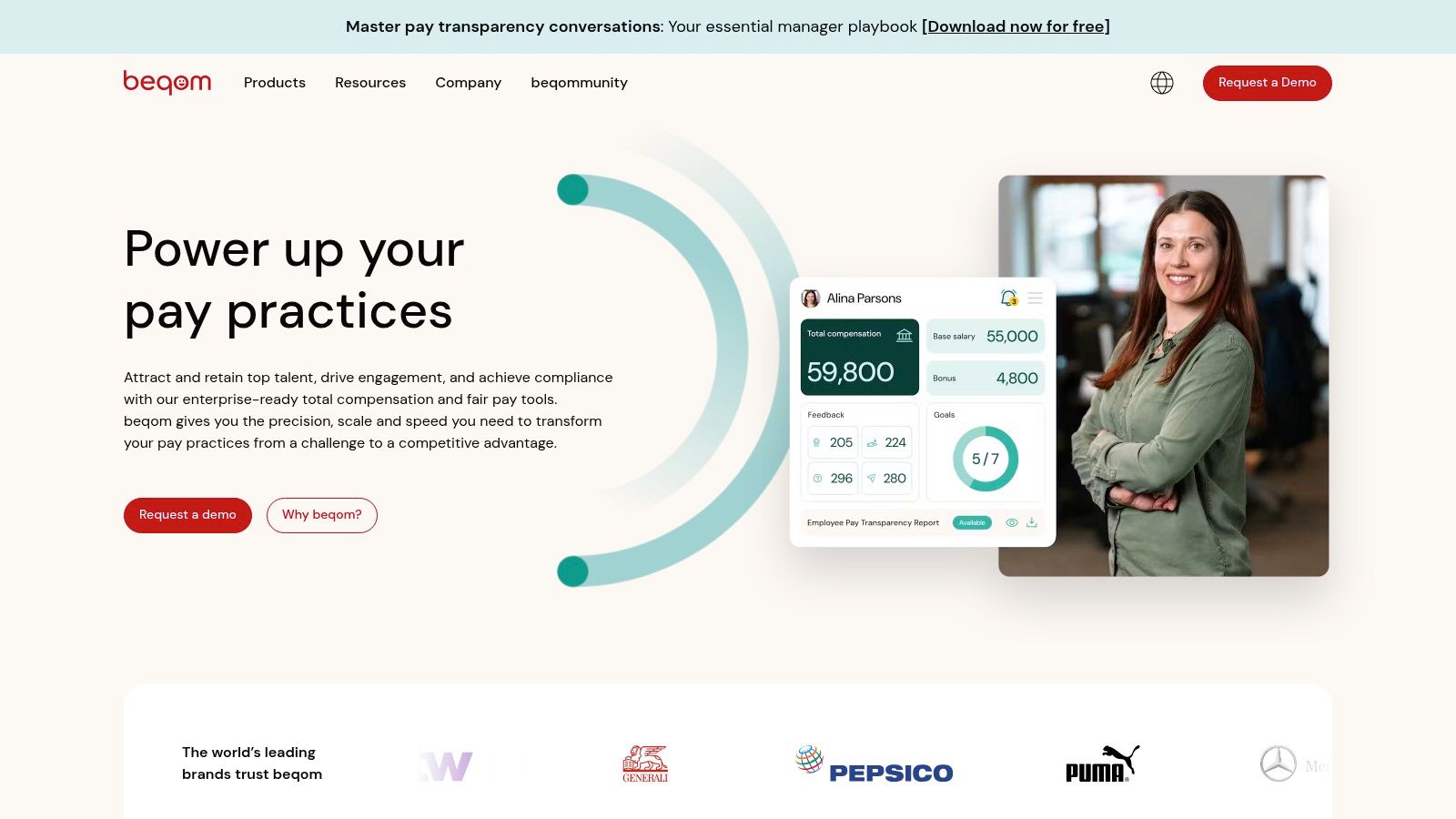
The platform places a strong emphasis on pay equity analytics and transparency, providing powerful tools to help HR leaders identify and remedy wage gaps. When evaluating total rewards, it's crucial to account for all components, including robust international benefits administration and other non-salary perks. beqom’s comprehensive approach ensures every element of compensation is visible and manageable. To better understand this, you can learn more about how to calculate total compensation.
Core Features & Analysis
- Comprehensive Cycle Management: Manages all facets of compensation, including salary reviews, bonus allocation, LTI vesting, and sales incentive payouts for large-scale workforces.
- Pay Equity & Transparency: Advanced analytics and reporting tools designed to meet global pay transparency regulations and internal DE&I goals.
- Global Scalability: Purpose-built to handle multiple currencies, languages, and complex business rules across different countries and business units.
- API-Driven Integration: Offers flexible integration capabilities to connect with existing HRIS, ERP, and other enterprise systems for seamless data flow.
Pricing and Implementation
beqom uses a quote-based pricing model tailored to the specific needs and scale of each enterprise client. The implementation process is thorough, reflecting its enterprise focus, and typically requires a dedicated project team and collaboration with beqom’s specialists to configure the platform for complex global requirements.
Our Take: For large, multinational enterprises struggling with disparate compensation systems, beqom is one of the best compensation management software solutions available. Its proven scalability and deep focus on compliance and pay equity are standout features. However, its enterprise-level complexity and pricing make it unsuitable for small to mid-sized businesses.
Website: https://www.beqom.com/
10. UKG Pro – HCM (Compensation features)
UKG Pro offers robust compensation planning capabilities as part of its comprehensive Human Capital Management (HCM) suite. It's designed for organizations seeking an end-to-end solution that connects compensation cycles directly to workforce management and payroll. This tight integration simplifies administration for complex salary reviews, bonus allocations, and total rewards communication, making it a strong contender for mid-to-large enterprises.
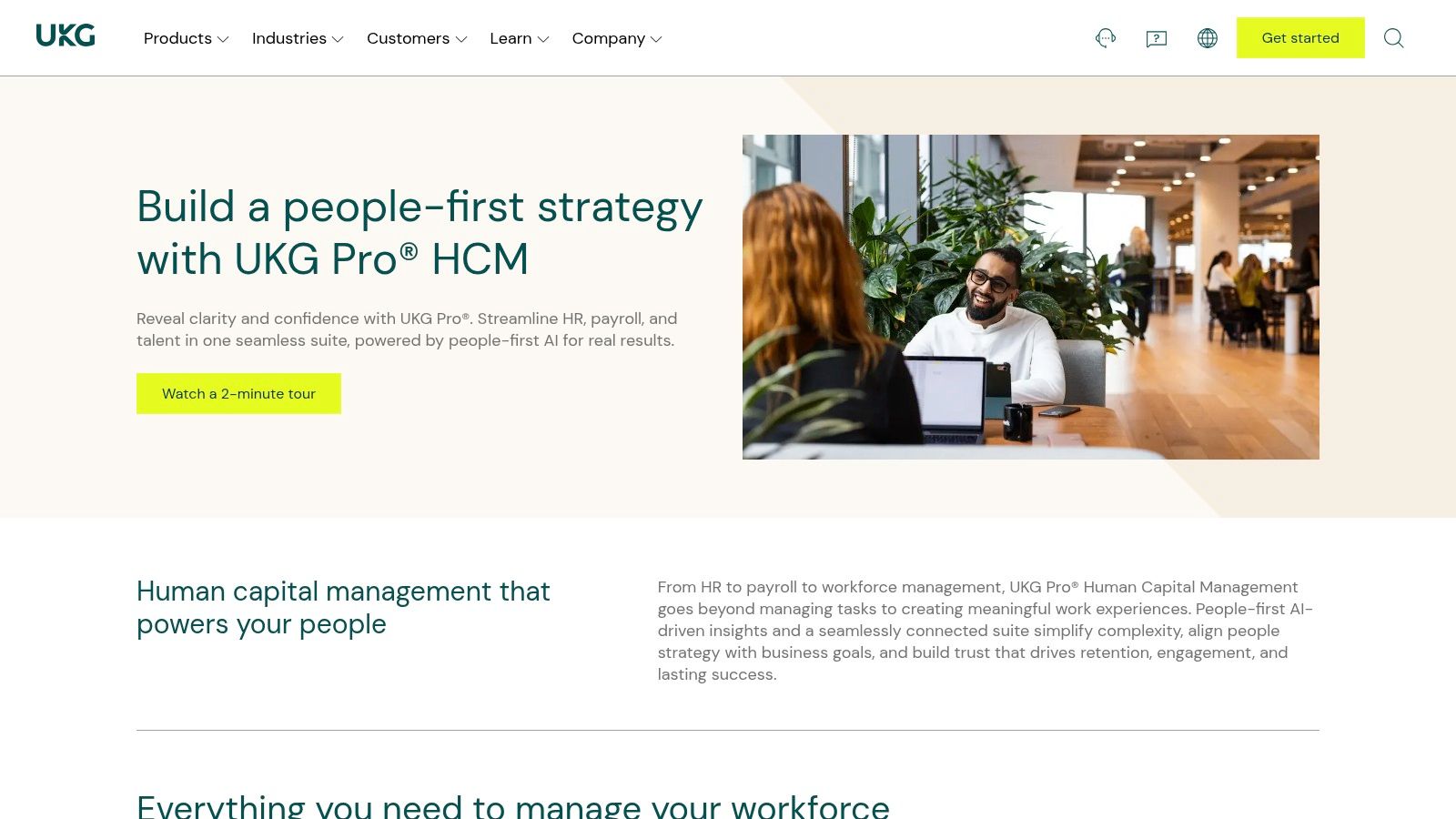
The platform is known for its strong US market presence and a continuous product roadmap that introduces new features like proration and improved data exports. By leveraging its broader suite, HR teams can access AI-assisted insights to inform compensation decisions, ensuring they align with overall business and talent objectives.
Core Features & Analysis
- End-to-End HCM Integration: Connects compensation planning directly with payroll, time, and talent data, providing a single source of truth for all employee information.
- Planning Worksheets & Statements: Equips managers with configurable worksheets for merit and bonus cycles and generates clear total rewards statements for employees.
- Global Workforce Support: The platform's workforce and payroll integrations extend across many countries, which is ideal for marketing organizations with international teams.
- AI-Assisted Insights: Utilizes AI within the broader suite to surface trends and analytics that can guide more strategic and equitable compensation strategies.
Pricing and Implementation
Like many enterprise HCM systems, UKG Pro’s pricing is quote-based and requires a consultation to determine the final cost based on module selection and employee count. The depth of compensation features is dependent on the specific suite configuration you choose. Implementation is a structured process supported by UKG's services team.
Our Take: For US-based mid-to-large enterprises needing a unified HCM system, UKG Pro provides one of the best compensation management software options by embedding it within a complete HR ecosystem. Its active community and strong support are significant advantages. However, companies looking for a lightweight, standalone compensation tool may find the full suite excessive.
Website: https://www.ukg.com/products/ukg-pro
11. Anaplan – Compensation Planning & Modeling
Anaplan is a powerful connected planning platform that excels in complex compensation planning and financial modeling. Rather than being a standalone HR tool, it acts as a high-performance modeling engine that integrates HR and finance data, making it ideal for large organizations needing to forecast the impact of compensation decisions on the overall business. Its strength lies in its ability to handle intricate what-if scenarios, headcount planning, and incentive compensation management at scale.

This platform enables leadership to connect workforce plans directly to financial budgets and forecasts in real-time. For marketing departments, this means you can model the budget impact of hiring sprees, new commission structures for sales-focused marketing roles, or merit increases across different global teams with precision. The flexibility allows for custom-built solutions tailored to specific business logic.
Core Features & Analysis
- What-if Modeling: Anaplan’s core strength is its scenario analysis, allowing leaders to model various compensation strategies and immediately see the financial repercussions.
- Global Headcount & Payroll Planning: Seamlessly handles multi-currency planning and consolidates workforce data for accurate, global payroll forecasting.
- Incentive Compensation Management (ICM): Provides robust capabilities for designing and managing complex variable pay and commission plans, crucial for performance-driven teams.
- HR & Finance Data Connectivity: Breaks down silos by connecting HR planning with corporate financial models, ensuring compensation strategies are aligned with business objectives.
Pricing and Implementation
Anaplan operates on a custom, quote-based pricing model that depends on the number of users, workspace size, and specific use cases. Implementation is a significant undertaking that typically requires certified partners or a dedicated internal team with modeling expertise. It is not a turnkey solution and should be planned as a strategic business project.
Our Take: For enterprise-level organizations where compensation planning is deeply intertwined with financial forecasting, Anaplan is one of the best compensation management software choices for its unparalleled modeling power. Its flexibility is a major advantage for creating custom plans and learning more about how to determine salary ranges. However, it's overkill for companies needing a simple, out-of-the-box compensation review tool.
Website: https://www.anaplan.com/resources/datasheets/compensation-planning/
12. G2 – Compensation Management Software Category
G2 is not a software tool itself, but a peer-to-peer review marketplace that serves as a powerful research starting point. Its compensation management category aggregates hundreds of verified user reviews, dynamic product rankings, and detailed feature comparisons. This makes it an invaluable resource for shortlisting vendors and understanding real-world user sentiment before committing to demos or trials.
The platform helps buyers cut through marketing noise by providing unfiltered feedback on everything from implementation to customer support. HR and marketing leaders can filter software by company size, satisfaction ratings, and specific features to quickly identify solutions that align with their operational needs and budget constraints.
Core Features & Analysis
- Verified User Reviews: Access authentic pros and cons from current users, providing insight into usability, ROI, and post-purchase support.
- Comparison Grids: Compare up to four products side-by-side on features, pricing models, and satisfaction scores to streamline the evaluation process.
- In-depth Category Reports: G2’s Grid Reports visually plot vendors based on market presence and user satisfaction, identifying leaders, contenders, and niche players.
- Filtering Capabilities: Narrow down the vast market by segment (small business, mid-market, enterprise), user ratings, and feature availability to find a relevant shortlist.
Pricing and Implementation
G2 is free to use for research and software discovery. Pricing and implementation details are specific to the individual vendors listed on the platform. The site provides direct links to request demos or quotes from the software providers.
Our Take: For any team starting their search for the best compensation management software, G2 is an essential first stop. It offers unparalleled market visibility and peer-driven insights that de-risk the purchasing process. While review scores can sometimes be influenced by vendor campaigns, it remains a critical tool for initial research and vendor discovery. Always validate findings directly with vendors.
Website: https://www.g2.com/categories/compensation-management
Top 12 Compensation Management Tools: Feature Comparison
| Product | Core features | UX & quality (★) | Price & value (💰) | Target audience (👥) | Unique selling points (✨) |
|---|---|---|---|---|---|
| 🏆 SalaryGuide | Marketing-focused salary DB (4,000+ recent vetted), AI career tools, job listings, employer dashboards | ★★★★★ — anonymous, secure, community success stories | 💰 Free core; Pro reports & API (paid; contact) | 👥 Marketers (digital/SEO/paid/content), HR & agencies | ✨ Marketing-specific data, 12‑mo vetted submissions, negotiation playbooks, anonymous bank‑level encryption |
| Workday – Compensation Management | Merit/bonus/stock planning, pay‑equity dashboards, eligibility rules, total rewards | ★★★★★ — enterprise-grade, secure, auditable | 💰 Quote-based, premium TCO | 👥 Mid–large orgs on Workday HCM | ✨ Deep Workday integration, scale, robust reporting |
| SAP SuccessFactors – Compensation | Guided planning cycles, variable pay, pay‑equity, training & docs | ★★★★☆ — mature global solution | 💰 Quote-based; enterprise pricing | 👥 Global orgs using SuccessFactors | ✨ Compliance focus, extensive training & ecosystem |
| Oracle Cloud HCM – Compensation | Manager worksheets, real‑time HR data, approval hierarchies, multi‑currency | ★★★★☆ — scalable, global | 💰 Quote-based | 👥 Large enterprises on Oracle HCM/ERP | ✨ Strong global allocations, ERP integration |
| ADP Workforce Now – Compensation | Interactive planning worksheets, budget dashboards, payroll updates, Marketplace apps | ★★★★☆ — solid payroll backbone, flexible add‑ons | 💰 Marketplace pricing varies; contact vendor | 👥 US mid–large orgs using ADP | ✨ Direct payroll sync, ADP Marketplace extensibility |
| Salary.com – CompAnalyst | Market pricing, pay‑equity analytics, salary structures, dashboards | ★★★★☆ — rich US benchmarking | 💰 Quote-based; modular costs | 👥 Compensation teams (US-centric) | ✨ Deep US survey data, templated workflows |
| Payscale (Payfactors/MarketPay) | AI market pricing, survey management, comp planning, rewards comms | ★★★★☆ — varies by module | 💰 Free Market Data tier; paid tiers for advanced features | 👥 SMB → Enterprise HR teams | ✨ Give-to-get data model, flexible tiers |
| Pave – Compensation Intelligence | Live benchmarks, ML pricing, planning workflows, total‑rewards portals, APIs | ★★★★☆ — modern UI, fast setup | 💰 Free base (connect data); paid Pro modules | 👥 Startups & fast‑growing tech firms | ✨ Predictive ML pricing, visual offer letters, APIs |
| beqom – Total Comp & Pay Equity | Salary/bonus/LTI/sales comp, pay‑equity, APIs, global compliance | ★★★★☆ — enterprise scale | 💰 Quote-based | 👥 Complex global enterprises | ✨ Purpose‑built for large scale & compliance |
| UKG Pro – HCM (Comp features) | Compensation worksheets, total rewards statements, payroll integrations, AI insights | ★★★★☆ — strong mid‑enterprise posture | 💰 Quote/demo required | 👥 US mid‑enterprise orgs | ✨ End‑to‑end HCM integration, active support community |
| Anaplan – Compensation Planning | What‑if modeling, scenario analysis, headcount & payroll planning, ICM | ★★★★☆ — powerful but requires expertise | 💰 Quote-based; implementation costs | 👥 HR & Finance teams needing complex modeling | ✨ Best‑in‑class scenario modeling & forecasts |
| G2 – Compensation Mgmt Category | Category grids, verified reviews, filters, vendor links | ★★★★☆ — timely peer feedback | 💰 Free research; vendor pricing separate | 👥 Buyers shortlisting compensation tools | ✨ Verified user reviews, comparative leaderboards |
Making Your Final Decision on Compensation Software
Navigating the crowded market for the best compensation management software can feel overwhelming, but the right platform is within reach. Throughout this guide, we've explored a wide spectrum of tools, from comprehensive enterprise systems like Workday and SAP SuccessFactors to specialized, data-driven platforms like Pave and SalaryGuide. Your final choice hinges on a strategic evaluation of your organization's unique context, goals, and operational realities.
The key takeaway is that there is no single "best" solution for everyone. The ideal platform is the one that aligns perfectly with your company's size, industry, and strategic objectives. A thorough internal audit is the crucial first step.
Key Factors to Guide Your Selection
Before you schedule another demo, take a moment to crystallize your priorities. Reflecting on the tools we've covered, from the robust HCM integrations of Oracle and ADP to the focused analytics of Salary.com and beqom, consider the following decision-making framework:
- Organizational Scale and Complexity: Are you a multinational enterprise requiring a global framework, or a nimble marketing agency needing focused, real-time benchmarks? Enterprise-grade solutions offer depth and breadth, while niche tools provide specialized agility.
- Integration Needs: How well must this new software play with your existing tech stack? A platform that seamlessly integrates with your HRIS, payroll, and performance management systems will prevent data silos and administrative headaches.
- Data Philosophy: Do you need traditional, survey-based salary data, or are you looking for modern, real-time market intelligence? Platforms like Pave and SalaryGuide are redefining compensation data for fast-moving industries, offering a level of granularity that legacy systems often lack.
- Strategic Goals: Is your primary objective to automate merit cycles, ensure pay equity, manage complex incentive plans, or attract top marketing talent? Your core business goals should be the primary driver of your software choice.
- Implementation and Support: What level of internal resources can you dedicate to implementation? Consider the total cost of ownership, which includes not just the subscription fee but also the time and expertise required for a successful rollout and ongoing maintenance.
Charting Your Path Forward: Actionable Next Steps
Making a confident decision requires a methodical approach. Use the insights from this article to build a shortlist of two to three top contenders that appear to be the best fit. Once you have your shortlist, it's time to dig deeper.
- Schedule Personalized Demos: Go beyond the standard sales pitch. Prepare a list of specific use cases relevant to your team, such as modeling a new bonus structure or benchmarking niche marketing roles.
- Ask Tough Questions: Inquire about their data sources, refresh rates, and security protocols. Ask for customer references from companies similar to yours in size and industry.
- Run a Pilot or Proof of Concept: If possible, request a trial or pilot program with a small, controlled group. This is the ultimate test of usability and will reveal how the software performs in your actual environment.
As you weigh your options for compensation management, it's beneficial to consider how these tools fit into the broader landscape of human resources technology. For organizations based in the UK, understanding the local market is crucial, and exploring the best HR software solutions for UK businesses can provide valuable context for building a cohesive and effective HR tech stack.
Ultimately, choosing the best compensation management software is a strategic investment in your most valuable asset: your people. The right tool will empower you to move beyond reactive adjustments and build a proactive, transparent, and equitable compensation strategy that not only attracts top talent but also fosters a culture of trust and high performance.
Ready to build a compensation strategy that attracts and retains top marketing talent? SalaryGuide provides the real-time, verified salary data you need to make confident decisions. Ditch outdated surveys and see how our platform offers unparalleled insights specifically for the marketing industry by exploring SalaryGuide today.